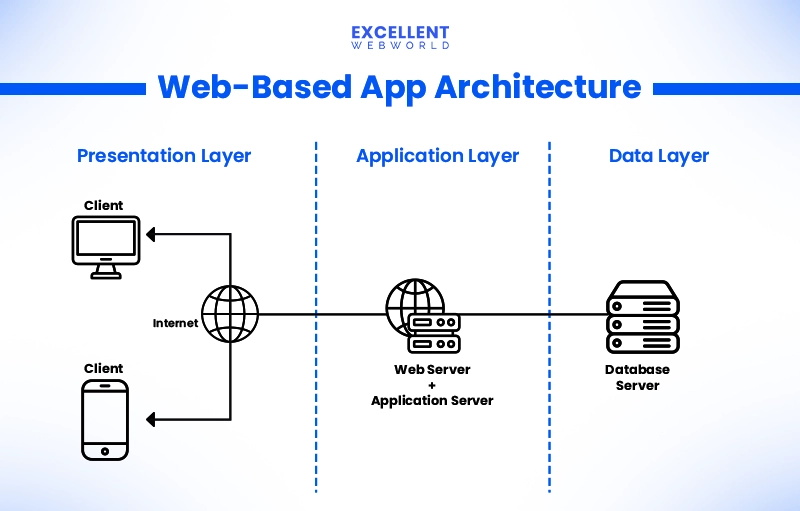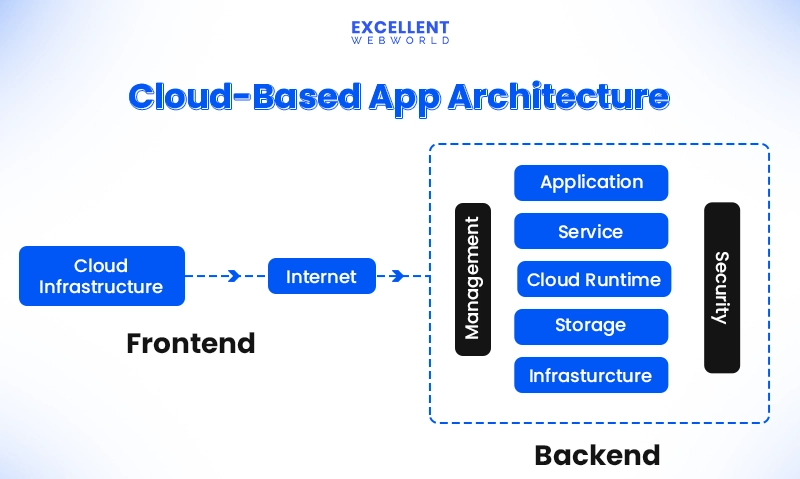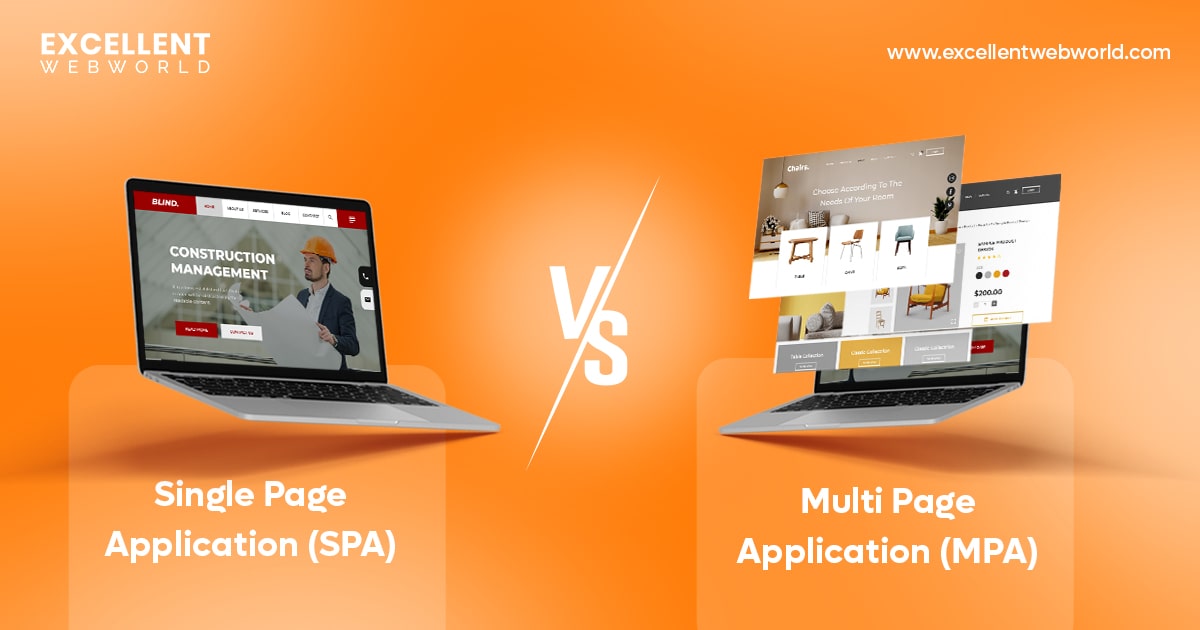Choosing between web-based vs cloud-based apps isn’t just a tech decision; it’s a business risk. Pick the wrong one, and you may end up with high costs, poor scalability, or security gaps that slow your growth.
Many leaders confuse web-based applications with cloud-based applications, thinking they deliver the same value. But in reality, they solve different problems. One is about how your team and customers access the app. The other is about how your business scales, secures, and manages it.
If you’ve ever compared a web app vs mobile app, you know the frustration of making a choice that feels “too technical.” This blog is designed to clear that confusion for you.
By the end, you’ll know the pros, cons, and use cases of each model, so you can confidently choose the right fit for your business today and future growth tomorrow.
What Are Web-Based and Cloud-Based Apps?
Web-based and cloud-based apps are two distinct approaches to delivering software solutions. Understanding what a cloud app and a web-based application are is crucial before deciding which option best fits your needs.
The debate about a web application vs cloud application revolves around how resources are managed, data is processed, and scalability is handled. These differences can significantly impact the app’s performance and flexibility depending on the business requirements.
What is a Web-Based App?
A web-based application runs in a web browser and doesn’t require users to download or install software on their devices. These applications process data and business logic using standard web technologies:
Understanding frontend vs backend processing in web apps is also essential. The frontend focuses on user interaction, while the backend is responsible for data management and business logic.
The architecture typically involves a client-server model, where the browser handles presentation while the server manages data processing. When developing complex web applications, choosing the right backend frameworks for web app development becomes crucial for scalability and performance.
What is a Cloud-Based App?
Cloud-based applications take web apps a step further by storing, managing, and processing data on remote servers hosted on the internet instead of local servers or personal computers. These apps utilize cloud service providers (AWS, Azure, Google Cloud) to handle infrastructure needs.
The primary difference between web application and cloud application designs is how resources are allocated and scaled. Cloud infrastructure can automatically adjust resources based on demand, making them more flexible than traditional web-based solutions. Other cloud computing advantages include reduced maintenance costs and improved accessibility.
There’s always a debate about comparing browser-based applications vs cloud-native solutions. Browser-based applications focus on delivering functionality through web interfaces. On the other hand, cloud-native solutions emphasize backend processing power and infrastructure flexibility. Many modern applications blend both approaches, with front-end components delivered through browsers and cloud-based backend services managing complex processing.
Understanding cloud app vs web app architecture is essential for choosing the best solution for their business needs, prioritizing universal access, powerful processing, or scalable infrastructure.
Core Architecture of Web-Based vs Cloud-Based Apps
Web-Based App Architecture
Web application architecture is the structural framework defining how components interact to create a functional web application. It follows a client-server model, which determines how the application performs and scales.
Communication between these layers occurs through HTTP requests and responses. When you interact with a web application, your browser sends a request to the web server, which routes it to the appropriate application server. After processing, the server returns the response to your browser for display.
Web applications typically rely on dedicated hosting environments with specific capacity limitations, which require careful planning for expected traffic and usage patterns.
Cloud-Based App Architecture
Cloud application architecture leverages distributed computing resources provided by cloud service providers. This includes models like SaaS, PaaS, and IaaS. Unlike traditional web hosting, cloud platforms offer dynamic resource allocation and management.
The SaaS, PaaS, and IaaS models represent different levels of cloud service abstraction, giving you flexibility in how much infrastructure you want to manage yourself.
Now that you understand the basics of web-based and cloud-based applications and how they work, let’s explore their differences and compare them using various benchmarks in the upcoming section.
Key Differences Between Web-Based and Cloud-Based Apps
1. Performance & Speed
Performance considerations should be at the forefront of mind when deciding between web-based and cloud-based applications. Web apps typically run directly in your browser, making them heavily dependent on your browser’s capabilities and local processing power. This dependency can limit their ability to handle complex operations efficiently.
In contrast, cloud-based apps process data on remote servers, allowing them to tackle high-compute tasks easily. The performance of web-based applications often suffers when handling data-intensive operations, while cloud solutions excel. Many developers at Excellent Web World working on Android app performance optimization have found that offloading processing to cloud infrastructure significantly improves responsiveness and user experience.
Latency in cloud computing is generally lower for resource-intensive tasks because specialized hardware handles the processing. When user demand fluctuates, cloud auto-scaling vs web scaling shows clear advantages, as cloud environments automatically adjust resources while web applications may struggle with traffic spikes. This difference becomes critical when your business experiences growth or seasonal demand changes.
The bandwidth usage in web vs cloud apps presents another consideration. Web applications often transfer complete application code to users’ devices, whereas cloud apps can send only necessary data, saving considerable bandwidth. Modern serverless web applications offer an interesting hybrid approach, combining responsive interfaces with powerful back-end processing.
| Performance Metric | Web-Based Apps | Cloud-Based Apps |
|---|---|---|
| Latency | Higher due to limited servers and congestion. | Lower with optimized network paths and edge computing. |
| Load Time | Slower, affected by fixed resources and traffic spikes. | Faster with better resource management and use of CDNs. |
| Processing Speed | Limited by server capacity, it slows under load. | Faster with dynamic resource allocation and distributed computing. |
| Server Cost | Fixed costs with upfront investments. | Pay-as-you-go model, reducing initial expenses. |
| Scalability | Requires manual scaling, leading to delays. | Auto-scaling adjusts seamlessly to demand. |
2. Scalability
Cloud-based apps automatically scale to meet demand. When traffic spikes, cloud infrastructure dynamically allocates resources, ensuring smooth performance without manual intervention. This elasticity allows businesses to handle sudden user surges without service disruptions or costly hardware upgrades.
On the other hand, web-based apps often face scalability limitations due to their hosting environments. Traditional web apps rely on fixed servers, which can become overwhelmed during high-traffic periods. Scaling requires manual adjustments, such as upgrading hosting plans or adding more servers, which takes time and resources.
Cloud apps benefit from on-demand scalability, optimizing costs by only using what is needed. In contrast, web apps may struggle with performance issues if demand exceeds their hosting capacity. Cloud-based apps provide a more efficient solution for seamless growth and flexibility.
3. Offline Functionality
Regarding offline access, web-based and cloud-based apps function quite differently. Web apps rely entirely on an internet connection, meaning you can’t use them if you’re offline. Since they operate through a browser, all interactions, updates, and data retrieval happen in real time over the web. If the connection drops, so does your access.
For example, consider an online project management tool like Trello’s web app. If you try to access your boards without an internet connection, the page will not load, and you cannot make updates. Since Trello’s web app runs on a browser and does not store data locally, offline access isn’t possible.
Cloud-based apps, on the other hand, offer greater flexibility. Many sync data automatically, allowing you to work offline and update changes once you’re back online. This is particularly useful for productivity tools, storage services, and collaboration platforms.
For example, Microsoft OneDrive and Google Drive offer offline access. If you lose connection while working on a Google Doc with offline mode enabled, all changes automatically sync once you’re back online.
Cloud apps are significantly advantageous if your work depends on consistent access to data and functionality. While web apps are efficient for real-time tasks, they don’t offer the same convenience in offline scenarios.
4. Security & Compliance
“In my years of working with cloud security, one truth stands out—reactive security is obsolete. The future lies in predictive and autonomous security models where AI continuously detects, adapts, and defends against evolving threats before they strike.” – Paresh Sagar, CEO, Excellent Webworld
Web apps rely on browsers, making them vulnerable to security risks in web-based applications like cross-site scripting (XSS), SQL injection, and session hijacking. Without a firewall for web applications, attackers can exploit these vulnerabilities, leading to data breaches. Additionally, web apps often store data on local servers, increasing the risk of unauthorized access and making compliance with regulations like GDPR compliance in cloud apps more challenging.
This is where cloud security offers a critical advantage. If you’re exploring What is Cloud Security?, you’ll see how cloud-based application security integrates encryption, multi-factor authentication, and AI-driven threat detection, ensuring data protection in cloud computing at every level.
Cloud providers enforce strict access controls, real-time monitoring, and automated security updates—elements often missing in traditional web apps. These proactive defenses reduce cyber threats and ensure businesses comply with evolving regulations.
“Cloud security is no longer just about protection—it’s about prediction. The future belongs to businesses integrating AI-driven threat intelligence, zero-trust architectures, and automated compliance to stay ahead of evolving cyber risks.” – Mayur Panchal, CTO, Excellent Webworld
Now that you understand the key differences between web-based and cloud-based apps, the next step is knowing when to choose one. The right choice depends on your business needs, from scalability and accessibility to security and cost. For example, a reliable Cybersecurity Services Provider can help you navigate security concerns for both types of apps.
In the next section, we’ll explore real-world use cases to help you determine whether a web or cloud app best fits your organization.
Business Use Cases – When to Choose Web or Cloud Apps?
Selecting between web-based and cloud-based applications depends on your industry needs, scalability requirements, and budget. Understanding their strengths can help you make the right decision.
Ideal Scenarios for Web-Based Apps
Web-based applications are best suited for businesses that need lightweight, easily accessible solutions. They are cost-efficient, easy to deploy, and require minimal infrastructure.
Consider web-based apps in the following scenarios:
Trello: Trello is a web-based task management tool with an intuitive drag-and-drop interface accessible from any browser. Its lightweight design reduces IT costs while enabling seamless team collaboration, making it ideal for small businesses and freelancers.
HubSpot: HubSpot’s web-based CRM vs cloud CRM approach highlights the difference between a browser-accessible CRM and a fully cloud-hosted one. Its web-based CRM is easier to implement and more cost-effective, making it an excellent choice for SMBs that don’t need deep cloud integrations.
Canva: Canva revolutionized graphic design with its fully web-based platform, allowing users to create content without high-performance hardware. Leveraging cloud storage and real-time collaboration, it is a go-to tool for startups, social media managers, and businesses needing quick, accessible design solutions.
Ideal Scenarios for Cloud-Based Apps
Cloud applications are ideal for businesses that require scalability, security, and seamless integration. Cloud based application development helps enterprises leverage the power of cloud solutions tailored to their needs.
Choose cloud-based apps in these scenarios:
Netflix: Netflix evolved from a DVD rental service into a global streaming giant by leveraging cloud computing for scalability and seamless content delivery. Its cloud-based infrastructure minimizes downtime, enhances performance, and enables AI-driven recommendations, ensuring a personalized user experience.
Salesforce: Salesforce revolutionized customer relationship management (CRM) with its fully cloud-based platform. Unlike traditional CRMs, it enables businesses to scale, automate sales processes, and securely manage customer data with real-time access and analytics.
Stripe: Stripe, a fintech leader, utilizes cloud computing for secure, scalable payment processing. Its cloud-based infrastructure ensures regulatory compliance, reduces fraud risks, and supports seamless API-driven transactions, making it ideal for businesses of all sizes.
Cost & Maintenance Comparison of Web vs. Cloud Application
Development & Deployment Costs
When choosing between web and cloud apps, it is crucial to understand the cost comparison during the initial investment. According to experienced software development services providers, Web apps generally have lower development costs since they run on standard web servers with minimal infrastructure needs. In contrast, cloud-based apps require a more extensive setup, including cloud hosting costs, server management, and security measures.
Cloud pricing models vary depending on the provider and usage. Many cloud platforms for startups offer flexible pricing, such as pay-as-you-go cloud computing, which allows scalable resource allocation. While this model ensures cost efficiency, a cloud hosting cost breakdown includes factors like storage, data transfer, and compute resources, which can drive up expenses if not optimized. Choosing the best cloud platform for startups, like AWS, Google Cloud, or Azure, requires evaluating pricing tiers, storage costs, and traffic handling capabilities.
Long-Term Maintenance & Upgrades
Web-based applications are easier to maintain since updates deploy directly to a central server, ensuring all users receive the latest version instantly. This simplifies maintenance and reduces operational overhead. However, the ROI of cloud-based apps vs web-based apps depends on factors like scalability, security, and ongoing infrastructure costs.
Due to their reliance on distributed computing, cloud-based apps require continuous management. Server performance, security, and compliance must be regularly monitored. While cloud platforms offer automation tools, skilled personnel are needed to optimize resources effectively. Cloud migration for web apps using AWS Cloud Consulting Services can improve performance and scalability, potentially increasing ROI, but it also introduces additional data transfer and reconfiguration costs that must be carefully evaluated.
Long-Term Cost Comparison
Below is a bar graph comparing long-term costs for web vs. cloud applications.
Web-based apps offer lower development costs and greater control, while cloud-based apps excel in scalability, hosting, and upgrades. The best choice depends on whether stability or flexibility is the priority.
Understanding these cost structures can help you decide whether a web—or cloud-based application fits your business.
Now that you know when to choose web or cloud apps, let’s look ahead. Emerging technologies like AI, automation, and enhanced security are reshaping their future. In the next section, you’ll explore key trends driving innovation—and what they mean for your business.
Future Trends – How Web and Cloud Apps are Evolving?
As technology advances, web and cloud applications are transforming to meet new demands. Businesses that embrace these changes can gain a competitive edge. Let’s explore key trends shaping the future.
Web-Based Apps Trends
Web applications are becoming more powerful and efficient. Progressive Web Apps (PWAs) continue to blur the lines between web and native mobile apps, offering faster performance and offline capabilities. Additionally, enhanced browser capabilities allow web apps to leverage APIs for better user experiences, from real-time collaboration to advanced graphics.
Businesses need a solid foundation to keep up with these advancements. Choosing the best tech stack for web application development is essential for building scalable, high-performing web apps that adapt to future trends.
Cloud-Based Apps Trends
Cloud applications evolve rapidly with cloud-native development, enabling businesses to scale seamlessly. AI automation in SaaS solutions streamlines operations, enhances user experiences, and reduces manual workloads. Meanwhile, serverless computing revolutionizes app deployment and management, offering cost efficiency and flexibility. With Google Cloud Consulting Services, organizations can accelerate their cloud transformation, optimize AI-driven automation, and leverage serverless computing for maximum efficiency.
The rise of hybrid cloud architectures allows companies to balance security, performance, and scalability, combining private and public cloud benefits. As these technologies evolve, businesses must stay ahead to maximize their potential.
Choosing the Right Model for Your Business – Final Decision Framework
| Factor | Choose Web-Based Apps If… | Choose Cloud-Based Apps If… |
|---|---|---|
| Budget | You have a limited budget and prefer lower upfront costs. | You can invest in scalable infrastructure and ongoing costs. |
| Performance Needs | Your app has basic functionality and doesn’t require heavy processing. | You need high performance, real-time data processing, and scalability. |
| Security | Standard security measures are sufficient for your use case. | Advanced security, compliance, and data encryption are required. |
| Growth Plan | Your app serves a fixed user base with minimal scalability needs. | You expect user growth and require scalable infrastructure. |
Input from reputable business IT consulting services can reveal overlooked operational constraints.
Mistakes to Avoid When Selecting an App Model
When choosing between web-based and cloud-based apps, avoid these common misconceptions:
Final Thoughts – Which One Should You Choose?
Your choice between web-based and cloud-based applications ultimately depends on your business requirements. Web-based apps offer simplicity and lower initial costs, while cloud solutions provide greater scalability and flexibility for growing companies.
Consider your long-term growth trajectory before making this decision. If you anticipate rapid expansion, a cloud-based approach might prevent costly migrations later. Many businesses start with web-based applications and gradually transition to cloud infrastructure.
Partnering with an experienced cloud application development company like Excellent WebWorld for complex implementation challenges can streamline your digital transformation journey. These specialists can assess your unique needs and develop customized solutions that align with your business objectives.
Decision-making for SaaS adoption shouldn’t be rushed. Evaluate your operational requirements before committing to either path. With proper planning, the migration from web-based to cloud-based apps becomes seamless. Consulting with experts for implementation, such as professional SaaS development services, can help ensure a smooth transition and that applications are designed to meet business goals.
FAQs
Web apps run in browsers and primarily handle the user interface. Cloud apps run on remote servers and can include front-end and back-end components. They offer more robust features and processing capabilities.
No, they’re not the same. Web apps run in browsers and have limited offline capabilities, while cloud apps operate on remote servers and offer more extensive features and better resource management.
It depends on your needs. Web apps are more straightforward and cheaper for essential functions, while cloud apps offer more scalability, features, and offline capabilities for complex business requirements.
Not necessarily. While cloud apps can have web interfaces, they can also be accessed through dedicated applications, APIs, or mobile apps without requiring a web browser.
Web apps using technologies like service workers can offer limited offline functionality, but cloud apps generally offer better offline capabilities with dedicated client applications.
Web apps use HTML, CSS, JavaScript, and frameworks like React. Cloud apps use these plus server technologies like Node.js, Python, Java, and cloud services from providers like AWS, Azure, or Google Cloud.
Cloud apps with dedicated infrastructure can implement more robust security measures, but both require proper security practices. The actual security depends on implementation quality rather than app type.
Web apps are initially cheaper to develop as they require fewer components. Cloud apps have higher upfront costs but may offer better long-term value for complex applications.
Cloud apps are generally more scalable as they can leverage cloud infrastructure to automatically adjust resources based on demand, while browser capabilities limit web apps.
Cloud apps offer more customization possibilities due to their broader technology stack and infrastructure options. On the other hand, web apps have more limitations because they are confined to browser environments.
Typical web-based applications include Gmail, Trello, Facebook, Twitter, and WordPress. These run primarily in browsers and focus on providing user interfaces for specific functions.
Popular cloud-based applications include Salesforce, Microsoft 365, Dropbox, Slack, and Adobe Creative Cloud. These leverage remote servers for complex processing and data storage capabilities.

Article By
Mahil Jasani began his career as a developer and progressed to become the COO of Excellent Webworld. He uses his technical experience to tackle any challenge that arises in any department, be it development, management, operations, or finance.






